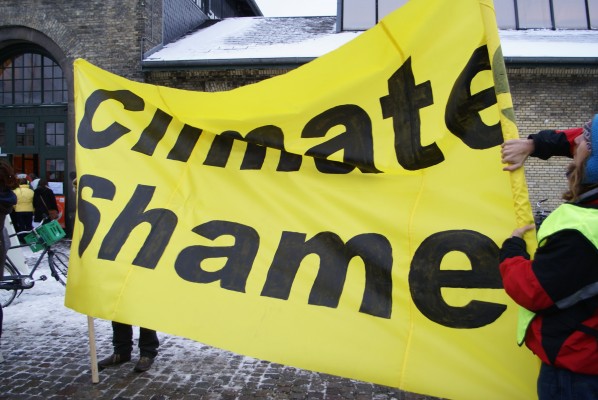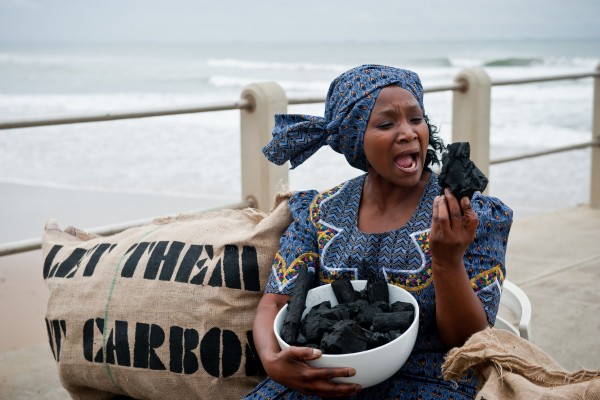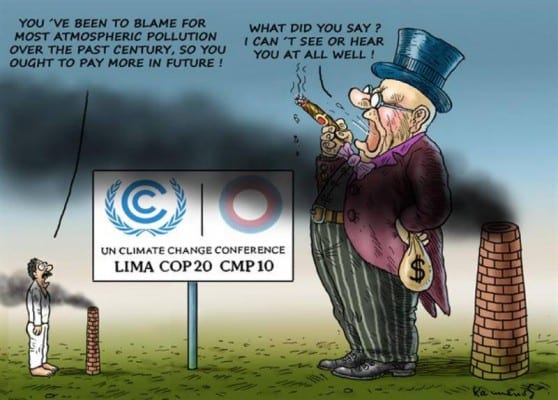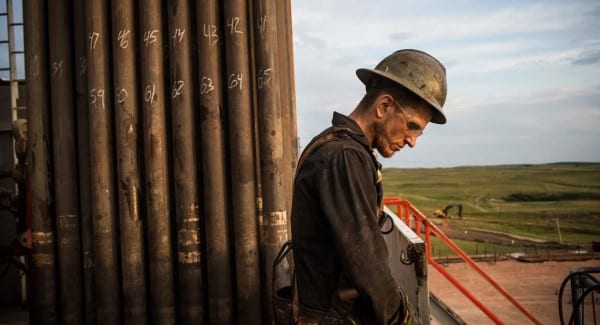DEATH BY A THOUSAND CUTS: EARTH ENTERS THE ‘DANGER ZONE’
A DISPATCH FROM MEDIA LENS (UK)

Environmental activists have a tough time attracting serious and consistent media attention. Meanwhile, we know what the media does with its awesome power. (WWF France, via flickr)
[dropcap]Last week,[/dropcap] announced that 2014 was the planet’s warmest year in the modern record, going all the way back to 1880. The ten warmest years have now occurred since 2000, with the sole exception of 1998 when there was a strong El Niño warming event in the Pacific Ocean.
Climate scientist Jennifer Francis of Rutgers University put the scale of global warming in stark perspective when she told Associated Press:
‘The globe is warmer now than it has been in the last 100 years and more likely in at least 5,000 years.’ (Our emphasis.)
Don Wuebbles, an atmospheric scientist at the University of Illinois, who has worked on reports for the UN Intergovernment Panel on Climate Change, said:
‘We have a clear signal that our climate is changing, and when you look at the evidence it’s because of human activities. ‘The evidence is so strong I don’t know why we are arguing any more. It’s just crazy.’
In fact, any rational argument about whether dangerous climate change is real, and whether humans are largely responsible, is long-settled. What is needed now is urgent action to cut carbon emissions based on the climate justice principles of precaution and equity.
“‘It’s clear the economic system [capitalism] is driving us towards an unsustainable future and people of my daughter’s generation will find it increasingly hard to survive.”

“Let them eat carbon.” Indeed. Oxfam’s stunt hits the target, but the lack of an effective response continues and is to be expected until the system itself is truly changed. Via Oxfam International, flickr)
The stakes could not be higher. In a recent in-depth piece, Dahr Jamail interviewed several scientists, including Professor Paul Beckwith of the University of Ottawa in Canada, a researcher in abrupt climate change. Beckwith warned:
‘It is my view that our climate system is in early stages of abrupt climate change that, unchecked, will lead to a temperature rise of 5 to 6 degrees Celsius within a decade or two. Obviously, such a large change in the climate system will have unprecedented effects on the health and well-being of every plant and animal on our planet.’
Professor John Schellnhuber, one of the world’s leading climate scientists, says that ‘the difference between two degrees and four degrees’ of warming ‘is human civilisation.’
Jamail noted that a study in Nature in 2013 warned that a 50-gigaton ‘burp’ of methane from thawing Arctic permafrost beneath the East Siberian sea is ‘highly possible at anytime.’ Because methane is a much more powerful global-warming gas than carbon dioxide, this methane ‘burp’ would be the equivalent of at least 1,000 gigatons of carbon dioxide. (For comparison, humans have released a total of around 1,475 gigatons of carbon dioxide since the year 1850.)
Human stress on the Earth’s environment has become so severe that the planet has entered the ‘danger zone’, making it much less hospitable to our continued existence. Researchers warn that life support systems around the globe are being eaten away ‘at a rate unseen in the past 10,000 years’. It is ‘a death by a thousand cuts’, shifting the world to ‘a warmer state, 5-6C warmer, with no ice caps’.
Professor Will Steffen, of the Australian National University and the Stockholm Resilience Centre, is the lead author of two new studies on ‘planetary boundaries’ being breached by human activity around the globe. He warns that although there would still be life on Earth, it would be disastrous for large mammals such as humans:
‘Some people say we can adapt due to technology, but that’s a belief system, it’s not based on fact. There is no convincing evidence that a large mammal, with a core body temperature of 37C, will be able to evolve that quickly. Insects can, but humans can’t and that’s a problem.’
He added ominously:
‘It’s clear the economic system is driving us towards an unsustainable future and people of my daughter’s generation will find it increasingly hard to survive. History has shown that civilisations have risen, stuck to their core values and then collapsed because they didn’t change. That’s where we are today.’
Climate expert Jørgen Randers, who co-authored the classic book The Limits to Growth in 1972, is similarly scathing about the current system of economics:
‘It is cost-effective to postpone global climate action. It is profitable to let the world go to hell.’
DRIFTING INTO A CYCLE OF SILENCE
What has been the corporate media’s response to Earth’s vital signs shooting into ‘red alert’ mode in recent years? As even casual observers will have noticed, the media’s attention to climate and the environment has dropped off alarmingly. Justin Lewis, Professor of Communication at Cardiff University, says that studies suggest that ‘media coverage of climate change – and environmental issues more generally – has declined precipitously since 2009/10’. In particular, British press coverage of climate change in 2012 was just twenty per cent what it was in 2007, even as the warning signs of climate chaos have become clearer. This is truly a scandal, even if entirely predictable.
And it’s not just British newspapers. Climate coverage by the country’s 10pm weekday flagship news programmes on both ITV and BBC has also dropped off sharply:
Kamal Ahmed and the BBC’s Scotland correspondent James Cook on Twitter about their failure to mention climate change in recent business reporting about the oil industry, we received no reply, despite other Twitter users retweeting and highlighting our challenges (via the ‘favourite’ option). Likewise, when we challenged Paul Royall, editor of BBC News at Ten, to justify his news programme’s significant drop in environment coverage (citing Professor Lewis’s article), he maintained his usual lofty silence. These journalists, and their like-minded colleagues, have no leg to stand on; and presumably they are well aware of that.
Lewis concludes of the shocking state of media coverage on climate:
‘We have thereby drifted into a cycle of silence, where lack of media coverage creates a sense of complacency in both public opinion and political debate.’
A NIGHTMARE COME TRUE
At times like these, the short-term business priorities of the commercial media, and their complicity in the onrushing climate chaos, are brought into sharp focus. Vanessa Spedding, a freelance journalist, took a snapshot of the front page of the Guardian website on January 15 and noted via Twitter:
‘Nightmare come true: @guardian leads on music and tech while casually throwing in (lower left) the end of the world.’
Of course, as mentioned, this was a snapshot of the Guardian website; it is possible that earlier in the day the story had briefly appeared in a more visible location. But the fact that it had swiftly sunk from prominence tells us much about the compromised state of even the most ‘environmentally-aware’ press.
The truth is that the Guardian has no interest in shaking things up, or playing a responsible role in public debate in the face of corporate-driven planetary exploitation threatening human civilisation. As we recently noted, the paper is owned by the Guardian Media Group which is ‘run by a high-powered Board comprising elite, well-connected people from… big business, finance and industry. This is not a Board staffed by radically nonconformist environmental, human rights and peace campaigners…nor anyone else who might threaten the status quo.’
Commenting on Professor Steffen’s analysis of the planet’s life support systems now collapsing, Jon Queally of the progressive CommonDreams website observed:
‘the world’s dominant economic model—a globalized form of neoliberal capitalism, largely based on international trade and fueled by extracting and consuming natural resources—is the driving force behind planetary destruction…’
You will search in vain for any Guardian editorial that recognises this grim reality, far less demands the transfer of corporate power into more responsible and accountable public hands.
What about green groups, many of whom look to the Guardian for favourable coverage of their campaigning and concerns? Will they ever recognise the folly of working with so-called ‘responsible’ elements of state and corporate power? In particular, has Jonathan Porritt, once the darling of the green movement in Britain, now finally woken up? A recent Guardian confessional by Porritt had the subheading:
‘Leading UK environmentalist Jonathon Porritt calls his years working on green energy projects with Shell and BP a “painful journey” that have led him to believe no major fossil fuel company will commit to renewables in the near future.’
Many radicals will feel they could have told him this 20 years ago; as several indeed did, ourselves included.
In 1996, Porritt, the former head of Friends of the Earth and one-time leader of the Green Party, co-founded Forum for the Future ‘to solve complex sustainability challenges’. Global corporations like BP and Shell would, we were told, be part of the solution, by boosting investment in renewable energy. Such moves, however, were both feeble and short-lived.
Meanwhile, the tantalising promise ‘Beyond Petroleum’ emblazoned BP ads everywhere, and there was much talk of ‘corporate social responsibility’ and shifting to ‘sustainable solutions.’ But these were no more than opportunistic, even cynical, PR stunts. Indeed, once the particular oil company bosses – who had spouted green-tinged rhetoric as they drifted towards retirement – had left BP and Shell, ‘hydrocarbon supremacists rapidly regained the ground they’d lost’. More accurately, perhaps, they had been in control all along.
Even when climate experts warned in 2013 that most of the carbon locked up in fossil fuel reserves should be left there, corporate executives were ‘unmoved’. Porritt laments:
‘these are companies whose senior managers know, as an irrefutable fact, that their current business model threatens both the stability of the global economy and the longer-term prospects of humankind as a whole. Once knowledge of that kind has been internalised, for any individual, however well-meaning and “sincere” they may be, it must get harder and harder to look oneself in the mirror every morning and feel anything other than moral regret.’
For Porritt himself:
‘This has been quite a painful journey for me personally. I so badly wanted to believe that the combination of reason, rigorous science and good people would enable elegant transition strategies to emerge in those companies.’
Porritt’s ‘pragmatic’ approach of working with ‘good, far-sighted people’ inside companies ‘capable of conducting their business “on a truly sustainable basis” ‘ has failed abysmally. Worse than that, as Guardian reader ‘kalahari’ asked Porritt underneath his article:
‘Has your involvement not to some extent legitimated these companies’ activities and actually forestalled the emergence of more radical political responses?’
This is a good question that progressive writers – Seumas Milne, George Monbiot, Owen Jones and others – might also wish to address when mulling over their continued employment by a media organisation that is so often complicit in shielding elite power from public challenges.
We are well aware that many, perhaps most, people do not want to hear any more about the coming era of climate chaos. We, too, would rather shut ourselves off from it. It would be all to easy to dismiss the subject; life is hard enough as it is. Why worry about something we seemingly cannot change, or that governments will deal with in the future somehow – however haltingly and inadequately – when the floodwaters rise, crops fail, climate refugees sweep across the continent, and wars are fought over diminishing resources?
We could think like that. Or we could take hope and inspiration from previous ‘impossible’ causes. When mass slavery was deemed an ‘inevitable’ part of the economy; and, indeed, of the social fabric of daily life. When people said that women would, and should, never be allowed to vote. When apartheid in South Africa appeared too ingrained to eradicate.
As ever, the late US historian Howard Zinn said it well:
‘We need to engage in whatever actions appeal to us. There is no act too small, no act too bold. The history of social change is the history of millions of actions, small and large, coming together at certain points in history and creating a power which governments cannot suppress.’
What is $1 a month to support one of the greatest publications on the Left?







DHD
10 minutes ago
Thank you so much, Mr. Kristof, for taking on issues related to animal cruelty and mistreatment in your column. I feel that you are using…
Bruce Joffe
10 minutes ago
Thank you for reminding us of this atrocious situation.I heard that the reason these chicken-abusers are not prohibited from such torturous…
Patricia Allan
10 minutes ago
I have not purchased Purdue products for years, and never will. I learned about their practices a while ago and stopped then. As teacher…